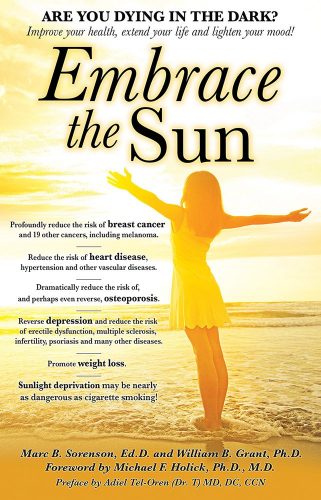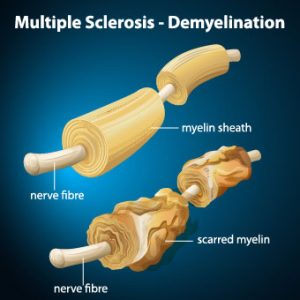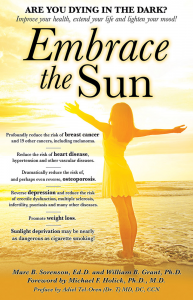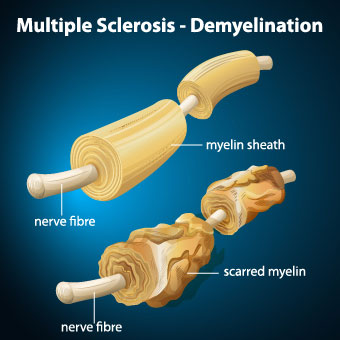MS is associated closely with lack of sun exposure and low vitamin D levels. So what is new? By Marc Sorenson, EdD
MS is a disabling autoimmune disease.
MS is an autoimmune disease in which T-cells initiate an inflammatory response against myelin. This process, known as demyelination, leaves the nerves bare and susceptible to “short circuiting.” As a result, communications between brain and body suffer damage. Eventually, the disease causes irreparable deterioration of nerves. Some of the effects of MS include numbness and weakness in limbs. In addition, there may be lack of coordination, loss of vision, lack of mobility, slurred speech and numerous other disorders.
What do we know about the connection between sun exposure and MS?
Sunlight is an immunomodulator. In other words, it may affect the functions of the immune system. In the case of an autoimmune disease, it may stop the immune system’s attack on its own tissue. Because sunlight stimulates the production of vitamin D in skin, it may suggest that vitamin D is protective. In addition, it also suggests the incidence should diminish in areas of high sun exposure, and increases in areas of low exposure.
Thus, the risk of MS in far northern areas is 100 times greater than in equatorial areas.
In equatorial areas, sunlight is intense, and the risk of the disease approaches zero. Another interesting study of immigrants to the UK (low sunlight), but born in the sunny West Indies is enlightening. Especially relevant is that these immigrants had one-eighth the rate of MS as their own children born in the UK. It therefore appears that childhood sun exposure provides protection against the disease.
Where does vitamin D fit?
While it is tempting to chalk up the association of low MS to high vitamin D (as mentioned above), use caution. As with certain other diseases, sun exposure may have a positive influence on MS, independent of vitamin D. For example, a study on animals assessed the relative affect of sunlight and vitamin D on the diseaase. The researchers concluded, “These results suggest UVR [sun] is likely suppressing disease independent of vitamin D production.” They also stated that vitamin D supplementation alone might not replace the ability of sun (UV) to reduce MS susceptibility.
Another more recent study found similar results.
The investigators used animals that had no vitamin D receptors (VDR), and therefore could not produce vitamin D. Therapy with UV light suppressed the disease. The investigators concluded that UV light suppression of MS occurs in the absence of vitamin D production.
Another recent investigation: High sun exposure and high vitamin D both associate with lessened severity of MS.
This study investigated the severity of the disease among people who already had MS. Thus, it was a unique study, to my knowledge. The investigators used the subjects’ latitude (a marker for sun exposure and vitamin D levels) and compared it to MS severity. Interestingly, high sun exposure and high vitamin D levels associated to a reduction in MS severity. However, the investigators listed only sunlight as a sure factor in reducing MS severity.
Hence, the investigators stated three salient points in their paper.
- “Observational studies suggested vitamin D-dependent effects, but prospective supplementation studies have so far been inconclusive….”
[This is an important, and a wake up call. Those who believe that we need only swallow a handful of pills, as we avoid the sun, are sadly mistaken. There is no way we can determine if high vitamin D blood levels are the reason for a reduction in MS severity. That is, unless we produce those levels in a scientific, controlled study using supplementation.]
- “Although [low] vitamin D cannot be proven as the causal factor, we provide evidence for clinically relevant effects of sunlight exposure.
- ”Furthermore, this study suggests sunlight triggered pathways other than vitamin D could play additional and modulatory roles as well.”
There you have it.
High sunlight exposure decreases the severity of multiple sclerosis. Vitamin D, though it is a miraculous nutrient, probably has little or no effect on the disease.
HAPPY SUNNING!
 You can find much more information on sun exposure and MS at sunlightinstitute.org. Also, read the book, Embrace the Sun.
You can find much more information on sun exposure and MS at sunlightinstitute.org. Also, read the book, Embrace the Sun.
Light exposure for the gut, by Marc Sorenson, EdD L
Light exposure for the gut seems like a strange concept. And, rest assured we will not discuss shining light directly into the gut to optimize health. However, light exposure, according to new research, may assist in gut homeostasis and may positively alter the gut microbiome.

Some words you should know to better understand light exposure for the gut:
Circadian rhythms: Circadian rhythms are variations in physiology and behavior persisting with a cycle length close to, but not exactly, 24 hours. It is necessary to synchronize the rhythms on a regular basis to maintain them. And, such synchronization is usually achieved through regular exposure to light and darkness.
Entrainment: Entrainment occurs when rhythmic physiological or behavioral events are matched to an external environmental factor. So it is ultimately the interaction between circadian rhythms and the environment, especially sunlight or darkness.
Homeostasis: The maintenance of metabolic equilibrium and balance within an animal by a tendency to compensate for disrupting changes. Thus, homeostasis is vital for good health. And conversely, a lack of homeostasis in the gut is a disease state.
Microbiome, or microbiota: A collection of microorganisms living in or on the human body. For the purposes of this discussion, we are interested in those microorganisms, such as bacteria, inhabiting the gut.
UVB: Ultraviolet B light, a part of the solar spectrum, which is also used in experiments by way of sun lamps.
Circadian rhythms: Circadian rhythms are variations in physiology and behavior persisting with a cycle length close to, but not exactly, 24 hours. It is necessary to synchronize the rhythms on a regular basis to maintain them. And, such synchronization is usually achieved through regular exposure to light and darkness.
Entrainment: Entrainment occurs when rhythmic physiological or behavioral events are matched to an external environmental factor. So it is ultimately the interaction between circadian rhythms and the environment, especially sunlight or darkness.
Homeostasis: The maintenance of metabolic equilibrium and balance within an animal by a tendency to compensate for disrupting changes. Thus, homeostasis is vital for good health. And conversely, a lack of homeostasis in the gut is a disease state.
Microbiome, or microbiota: A collection of microorganisms living in or on the human body. For the purposes of this discussion, we are interested in those microorganisms, such as bacteria, inhabiting the gut.
UVB: Ultraviolet B light, a part of the solar spectrum, which is also used in experiments by way of sun lamps.
First of all, let’s discuss the effect of light exposure on gut homeostasis.
There are specialized cells in the body called ILC3s, which are major regulators of inflammation, infection, microbiota composition and metabolism in the gut.
These cells do not function well if they are not synchronized to the biological clock (or circadian rhythm). So, the most effective way to assure that these cells are working is through external light exposure, particularly sunlight. Light signals are the major entraining cues of ILC3s.
In fact, as a result of the removal of circadian regulators in intestines, the researchers showed that many problems occur. Without regulators, light exposure can’t do its job, and therefore the circadian rhythms of the gut would be extinguished. Why? Because ILC3s could not connect to those regulators in the gut. Thus, this caused disrupted homeostasis, impaired epithelium, a deregulated microbiome, increased infection and disrupted lipid metabolism. The researchers stated that “Our work reveals a circadian circuitry that translates environmental light cues into enteric [intestinal] ILC3s, shaping intestinal health, metabolism and organismal homeostasis.” So the bottom line is, for gut health, get your sun exposure daily!
[intestinal]
Secondly, another investigation provides more information regarding light exposure and the gut microbiome.
Light exposure, vitamin D and microbiome makeup are all associated with inflammatory conditions like multiple sclerosis and inflammatory bowel disease. Therefore, scientists hypothesized that a causal chain links the three. So to test the hypothesis, they used female volunteers in a scientific experiment. In addition to three one-minute sessions of full-body UVB exposures, the volunteers had their blood vitamin D levels tested. Furthermore, before and after treatment, stool samples were taken for analysis of volunteers’ gut microbiomes.
The results regarding UVB light exposure and gut microbiome.
As a result of this minuscule UVB light exposure, good bacteria increased in the microbiome, as did vitamin D. Another fact mentioned in the paper was that studies in rodents indicated UVB increased good bacteria while decreasing harmful bacteria. So does this prove vitamin D could be responsible for lessening risk of multiple sclerosis (MS) and inflammatory bowel disease? No. It is especially relevant that many studies on vitamin D supplementation and MS show no effect. The one consistent outcome of the studies is that sun exposure always lessens the risk of MS. Sun exposure produces the marvelous hormone, vitamin D, but it also produces serotonin, endorphin, nitric oxide, BDNF and dopamine. In addition, there are many more photoproducts produced by sun exposure, which have not been fully studied for health benefits.
When possible, use sun exposure or other UVB light exposure to produce your vitamin D.
Therefore, vitamin D levels are, in many cases, surrogate measurements for sun exposure. The health benefits attributed to vitamin D may be due to other factors also being produced by sun exposure. The sun should be used holistically when possible. Using only one photoproduct of sun exposure seems like a mistake. Thus, it is much like extracting a single plant vitamin. That vitamin doesn’t have the health benefits of the entire plant, because it lacks fiber and other nutrients. Therefore, the closest thing to holistic sun is the use of a sunlamp or a sunbed. For more information, visit the sunlight Institute website.
In conclusion, take care of your gut and your health through non-burning, regular sun exposure.

For more information on sun exposure and MS, read the book, Embrace the Sun. Read more on circadian rhythms on http://sunlightinstitute.org/
Multiple sclerosis is a sunlight-deficiency disease. Another reason to embrace the sun. By Marc Sorenson, EdD
 First of all, multiple sclerosis is a terrible autoimmune disease in which immune cells attack myelin, the protective nerve cover.[1], [2] Hence, this process, known as demyelination, leaves the nerves bare and susceptible to “short circuiting.” This results in a debilitating disease which is often characterized by severe neural and muscular impairments. It may also result in sensory losses, bladder dysfunction, pain and visual problems due to nerve damage.
First of all, multiple sclerosis is a terrible autoimmune disease in which immune cells attack myelin, the protective nerve cover.[1], [2] Hence, this process, known as demyelination, leaves the nerves bare and susceptible to “short circuiting.” This results in a debilitating disease which is often characterized by severe neural and muscular impairments. It may also result in sensory losses, bladder dysfunction, pain and visual problems due to nerve damage.
MS is a big problem!
And recent findings, from National MS Society, estimate 1 million people in the United States have multiple sclerosis. Furthermore, this is more double the last reported number, and the first national research on multiple sclerosis prevalence since 1975. Consequently, it is estimated that about 200 new cases are diagnosed each week in the United States.[3]
Multiple sclerosis and sun exposure: What does new research say?
While no one disputes the horror of an increasing MS rate, a new study reiterates the vital need for sun exposure to prevent MS. Also, we are not surprised about the latest research. Why? Because the new study is simply a reiteration of myriad research papers and opinions showing that more sunlight reduces the risk.
In this research, 151 MS patients defined their previous lifetime sun exposure in the different seasons by questionnaire. In addition, they were compared to 235 non-patients who answered identical questionnaires.[1] As a result, those living in high-UVB areas experienced a 45% lower risk of multiple sclerosis. Living in those areas at ages 5 to 15 years also was associated with a reduced risk of 51-52%. UVB, of course, is a spectrum of light that emanates from the sun and causes tanning. In addition, it is used in sunbeds and sun lamps.
The conclusion regarding MS and sunlight.
In conclusion to their research, the authors stated, “Living in high ambient UVB areas during childhood and the years leading up to MS onset was associated with a lower MS risk. High summer sun exposure in high ambient UVB areas was also associated with a reduced risk.”
While this research is impressive, there is a plethora of additional science. Most noteworthy are the studies that follow. And, all show the association of sun exposure to lowered risk of MS.
Multiple sclerosis and the Davenport study
Probably, the most important early study was from 1922 by Dr. Charles Davenport. He wrote a paper entitled, “Multiple Sclerosis from the standpoint of geographic distribution and race.”[2] He analyzed the multiple sclerosis rates of military draftees and compared it to their states of origin. As a result, he showed that the highest rates were found in men who grew up in Michigan, Wisconsin, and the extreme northwest. These areas, of course, have very low sun availability. There were only a few cases of MS among those who grew up in southern states, where sun availability is abundant. In addition, Dr. Davenport also noted that draftees from urban areas, and where sun availability is low, had 50% higher MS rates than those who came from rural areas. Similar studies confirm that relationship. [3],[4] In 1979, assessments of the MS rates of USA military personnel Produced nearly identical results.[5]
Reducing relapse of multiple sclerosis through sunlight and/or vitamin D.
Mowry and colleagues, in correlating serum vitamin D to the rate of disease relapse, have reported the following: For every increase in serum levels of 10 ng/ml [25 nmol/L], there is a 34% decrease in the risk of relapse in young people.[6] Especially relevant, however, is that 90% of serum levels is derived from sun exposure. And, we also know that sun exposure has protective effects on MS beyond vitamin D.[7] Also, in the aforementioned research on vitamin D, high levels may really be surrogate measures for sun exposure. Sunlight and vitamin D are not the same.
More hours of sun equal lower risk of multiple sclerosis.
Most noteworthy, among people living in geographical locations, where there are 3,000 hours of available sun yearly, multiple sclerosis rates are quite low. [8] The same relationship exists when latitudes are correlated with rates of MS: And, The risk of MS in far northern areas is more than 100 times greater than it is in equatorial areas, where sunlight is intense, and the rate of MS approaches zero.[9], [10]
Therefore, for all who would like to prevent MS or reduce its exacerbation, soak up some regular, non-burning, safe sunlight. In conclusion, this is another of the wonderful benefits of our magnificent sun. It seems like a good time to indulge before the winter comes.
Finally, for more information on multiple sclerosis, read my new book, Embrace the Sun, available at Amazon.
References and footnotes
[1] Helen Tremlett, PhD, Feng Zhu, MSc, Alberto Ascherio, MD, DrPH, and Kassandra L. Munger, ScD.
[2] Davenport, C. Multiple Sclerosis from the standpoint of geographic distribution and race. Arch Neurol Psychiatry 1922;8:
[3] Acheson ED, Bachrach CA, Wright FM. Some comments on the relationship of the distribution of multiple sclerosis to altitude, solar radiation and other variables. Acta Psychiat (Scand) 1960;35 (suppl 147):132-47.51-58
[4] Norman JE Jr, Kurtzke JF, Beebe GW. Epidemiology of multiple sclerosis in USA veterans: 2. Latitude, climate, and risk of multiple sclerosis. J Chron Dis 1983;36:551-59
[5] Kurtzke JF, Beebe GW, Norman JE Jr. Epidemiology of multiple sclerosis in USA veterans: 1. Race, sex, and geographic distribution. Neurology 1979;29:1228-35.
[6] Mowry EM, Krupp LB, Milazzo M, Chabas D, Strober JB, Belman AL, McDonald JC, Oksenberg JR, Bacchetti P, Waubant E. Vitamin D status is associated with relapse rate in pediatric-onset MS. Annals of Neurology 2010;10.1002.
[7] Pantazou V, Schluep M, Du Pasquier R. Environmental factors in multiple sclerosis. Presse Med. 2015 ;44(4 Pt 2):e113-20.
[8] Goldberg, P. Multiple sclerosis: vitamin D and calcium as environmental determinants of prevalence (a viewpoint). Part I: sun, dietary factors and epidemiology. Int J Environ Studies 1974;6:19–27.
[9] Alter M, Yamoor M, Harshe M. Multiple sclerosis and nutrition. Arch Neurol l974;31:267-72.
[10] Kurtkze, J. Geography in multiple sclerosis. J Neurol 1977;215:1-26.
[1] Racke, M. Immunopathogenesis of multiple sclerosis. Ann Indian Acad Neurol. 2009 Oct–Dec; 12(4): 215–220.
[2] Markovic-Plese S, McFarland HF. Immunopathogenesis of the multiple sclerosis lesion. Curr Neurol Neurosci Rep 2001;1:257-62
[3] https://www.healthline.com/health/multiple-sclerosis/facts-statistics-infographic#2
MS prevention by sunlight. By Marc Sorenson, Ed.D. Sunlight Institute
What is MS?
MS is a painful, debilitating, crippling, disease in which immune cells initiate an inflammatory response against myelin. Myelin is the nerves’ protective cover. It is rather like an electric wire that has lost its rubber cover. So, this process, known as demyelination, leaves the nerves bare and susceptible to “short circuiting.” From 85 to 170 people per 100,000 in the USA suffer from MS, and the rate among women, during the period from 1991 through 1994, has increased by 50% compared to the period from 1982 through 1986. Also, as of 2010, the last year for which we could find statistics, there were 350,000-400,000 cases diagnosed in the USA.
There is no doubt that sunshine reduces the risk of MS, because The risk of multiple sclerosis in far northern areas, where there is little sunshine, is more than 100 times greater than it is in equatorial areas. So, in those areas, where sunlight is intense, due to directness of the sun, the rate of MS approaches zero. [1], [2], [3]
And do you know anyone who suffers from multiple sclerosis? They should probably read this blog and then obtain plenty of non-burning sun exposure.
The latest Research on MS, sun exposure and vitamin D.
A study carried out in Southern California corroborates the sun exposure benefits to MS reduction.[4] First of all, the researchers recruited members of three different ethnicities (blacks, Hispanics and whites). In addition, they further divided those ethnicities into those who suffered from MS (known as cases) and those who were free from the disease (controls). They then simultaneously examined lifetime sun exposure and blood vitamin D levels, accounting for genetic ancestry and other factors. The results were impressive:
- Among blacks, the highest lifetime sun exposure was associated with a 47% lower risk, independently of blood levels of vitamin D.
- Among whites, the highest lifetime sun exposure was associated with a 32% lower risk. In this group, highest vitamin D levels also associated with a lower risk of MS.
- Among Hispanics, the highest lifetime sun exposure was associated with a 34% lower risk, independently of blood levels of vitamin D.
This is just the latest research to determine that sun exposure lessened the risk of MS independently of vitamin D. In addition, researchers used animals with experimental autoimmune encephalomyelitis (EAE) (an experimental form of MS). It was induced in animals in a lab setting and then used to determine the relative influences of UVR and vitamin D on MS. In conclusion, they stated, “These results suggest UVR [sun] is likely suppressing disease independent of vitamin D production. Thus, vitamin D supplementation alone may not replace the ability of sun (UV) to reduce MS susceptibility.”[5]
More on sunlight and MS from the same researchers
Later on, some of these same researchers investigated the mechanism by which sun exposure suppressed the disease and determined that UV light selectively inhibits spinal cord inflammation and demyelination.[6]
Furthermore, in another study, scientists performed an investigation with UVR. UVR is the same radiation emitted by the sun and sunbeds or sunlamps. It was administered to animals with EAE.[7] First of all, the researchers found that UVR treatments stopped inflammation and demyelination of the spinal cord. It did so by inhibiting a chemical known as a chemokine, also known as a cytokine. Cytokines are specialized proteins that are either inflammatory or anti-inflammatory in their nature. Therefore, inflammatory cytokines or chemokines are the cause of inflammation and autoimmune attacks resulting in MS. In addition, UVR directly initiated the MS-ameliorating effects, independent of vitamin D.
To conclude:
Finally, as wonderful as vitamin D is, we should realize this: The production of vitamin D is only one of the profoundly healthful effects that are due to Sun Exposure. Hence, those who take vitamin D and believe they will derive all the benefits of sun exposure, are wrong. Consequently, they could be “dead wrong” in the case of a scourge like MS. So, be sure to obtain your full share of non-burning sunlight whenever possible. It could save your life. And, it could save the lives of those who have the disorder or who might be susceptible to it. Maybe we should start paying more attention to our sun exposure?
This is one of many blogs that I and others have written on this subject. In addition, here are a few more that may interest you:
http://sunlightinstitute.org/research-shows-sun-exposure-thwarts-multiple-sclerosis-ms/
http://sunlightinstitute.org/a-vitally-important-study-on-sunlight-and-multiple-sclerosis-ms/
Embrace the sun! Without burning, of course
[1] Alter M, Yamoor M, Harshe M. Multiple sclerosis and nutrition. Arch Neurol l974;31:267-72.
[2] Kurtkze, J. Geography in multiple sclerosis. J Neurol 1977;215:1-26.
[3] Hayes CE, Cantorna MT, DeLuca HF.Vitamin D and multiple sclerosis. Proc Soc Exp Biol Med 1997;216:21-27
[4] Langer-Gould A, Lucas R, Xiang AH, Chen LH, Wu J, Gonzalez E, Haraszti S, Smith JB, Quach H, Barcellos LF. Nutrients. 2018 Feb 27;10(3).
[5] Becklund BR, Severson KS, Vang SV, DeLuca HF. UV radiation suppresses experimental autoimmune encephalomyelitis independent of vitamin D production. Proc Natl Acad Sci U S A. 2010;107:6418-23.
[6] Wang Y, Marling SJ, Beaver EF, Severson KS, Deluca HF. UV light selectively inhibits spinal cord inflammation and demyelination in experimental autoimmune encephalomyelitis. Arch Biochem Biophys. 2015 1;567:75-82
[7] Wang Y, Marling SJ, Beaver EF, Severson KS, Deluca HF. UV light selectively inhibits spinal cord inflammation and demyelination in experimental autoimmune encephalomyelitis. Arch Biochem Biophys. 2015 1;567:75-82.
 Sun exposure is crucial to preventing multiple sclerosis (MS), the terrible, debilitating autoimmune disease in which T-cells initiate an inflammatory response against myelin, the protective cover of nerves.[1],[2] This leaves the nerves bare and susceptible to “short circuiting,” a process known as demyelination. This attack prevents proper functioning within the brain and body, which leads to a variety of symptoms like vision changes, muscle spasms, and numbness. These symptoms profoundly decrease the ability to function and destroy the quality of life.
Sun exposure is crucial to preventing multiple sclerosis (MS), the terrible, debilitating autoimmune disease in which T-cells initiate an inflammatory response against myelin, the protective cover of nerves.[1],[2] This leaves the nerves bare and susceptible to “short circuiting,” a process known as demyelination. This attack prevents proper functioning within the brain and body, which leads to a variety of symptoms like vision changes, muscle spasms, and numbness. These symptoms profoundly decrease the ability to function and destroy the quality of life.
We have known for decades that people who live in areas of low sun exposure, such as far-northern or far southern countries, have a far greater risk of contracting MS than those who live in countries closer to the equator. In fact, there is more than 100 times the risk of MS in far northern as in equatorial areas, where sun is intense, and the rate of MS approaches zero.[3],[4],[5]
I ran across an interesting study demonstrating that the age at which the low sun exposure occurs is also a predictive factor in the risk of MS.[6] It showed that in Norway, the amount of sun exposure in the period of life between 16-18 years of age was critical in predicting the disease. Those youngsters who experienced the lowest sun exposure during those ages were 83% more likely to develop MS. The same research showed that in Italy the critical period was between birth and age 5 years, with those receiving the lowest sun exposure being 56% more likely to develop MS.
I spite of incontrovertible research that proves regular, non-burning sun exposure is critical for human health, the sunscare movement continues to promote the idea that we should avoid the sun. The blood is on their hands.
[1] Racke, M. Immunopathogenesis of multiple sclerosis. Ann Indian Acad Neurol. 2009 Oct–Dec; 12(4): 215–220.
[2] Markovic-Plese S, McFarland HF. Immunopathogenesis of the multiple sclerosis lesion. Curr Neurol Neurosci Rep 2001;1:257-62
[3] Alter M, Yamoor M, Harshe M. Multiple sclerosis and nutrition. Arch Neuroll974;31:267-72.
[4] Kurtkze, J. Geography in multiple sclerosis. J Neurol1977;215:1-26.
[5] Hayes CE, Cantorna MT, DeLuca HF. Vitamin D and multiple sclerosis. Proc Soc Exp Biol Med 1997;216:21-27
[6] Bjørnevik K, Riise T, Casetta I, Drulovic J, Granieri E. et al. Sun exposure and multiple sclerosis risk in Norway and Italy: The EnvIMS study. Mult Scler. 2014 Jul;20(8):1042-9.
 By Marc Sorenson, EdD, for sun exposure.
By Marc Sorenson, EdD, for sun exposure.
According to a new study, people with MS feel better when they spend more time in the sunshine.[1] Not only will they feel better, but they will have lower rates of fatigue, and a slower progression to disability. None of this should be a surprise, since similar results have been reported for decades. For example, in 1922 Dr. Charles Davenport wrote a paper entitled, “Multiple Sclerosis from the standpoint of geographic distribution and race.[2] He analyzed the MS rate of military draftees and compared it to their states of origin. The highest rates were found in men who grew up in Michigan, Wisconsin, and the extreme northwest—all areas with low sun availability. There were few cases of MS among those who grew up in southern states, where sun exposure is abundant. He also noted that those from urban areas, which have lower sun availability than rural areas, had 50% higher MS rates than those from rural areas. Similar studies confirm that relationship.[3] [4]
Another interesting research paper demonstrated that sun exposure, while obviously being critical in the production of vitamin D, had its own profound influence in lessening the degeneration of nerves (neurodegeneration) in those with MS.[5] By measuring whole brain volume (WBV) and grey-matter volume (GMV) by magnetic resonance imaging (MRI), the scientists determined that greater summer sun exposure predicted greater WBV and GMV in MS patients. Interestingly though, when vitamin D levels were measured, they had no influence on the positive effects of sun exposure with WBV or GMV. The researchers concluded: “Sun exposure may have direct effects on MRI measures of neurodegeneration in MS, independently of vitamin D.”
Be sure that you soak up your share of sunlight, without burning of course. It may indeed save your life!
[1] https://multiplesclerosisnewstoday.com/2017/02/24/actrims2017-sun-exposure-may-lower-fatigue-slow-disability-progression-in-ms/
[2] Davenport, C. Multiple Sclerosis from the standpoint of geographic distribution and race. Arch Neurol Psychiatry 1922;8:
[3] Acheson ED, Bachrach CA, Wright FM. Some comments on the relationship of the distribution of multiple sclerosis to altitude, solar radiation and other variables. Acta Psychiat (Scand) 1960;35 (suppl 147):132-47. 51-58
[4] Norman JE Jr, Kurtzke JF, Beebe GW. Epidemiology of multiple sclerosis in USA veterans: 2. Latitude, climate, and risk of multiple sclerosis. J Chron Dis 1983;36:551-59
[5] Zivadinov R, Treu CN, Weinstock-Guttman B, Turner C, Bergsland N, O’Connor K, Dwyer MG, Carl E, Ramasamy DP, Qu J, Ramanathan M. Interdependence and contributions of sun exposure and vitamin D to MRI measures in multiple sclerosis. J Neurol Neurosurg Psychiatry. 2013 Oct;84(10):1075-81.
By Marc Sorenson, EdD. Sunlight institute… sun exposure
If only those who suffer from MS had known the truth when they were younger! Getting plenty of sun exposure might have saved them from the ravages of this horrible disease. Much has been written about the influence of vitamin D on MS, and in this blog, I have pointed out that sun exposure may be more important than vitamin D. A new study conducted in Australia, and presented at the 32nd Congress of the European Committee for Treatment and in MS in Research in London, England, is interesting in the way it was conducted.[1]
By questionnaire, the researchers used past and present sun exposure as a surrogate for vitamin D levels and concluded that historical, but not current, vitamin D levels protect against MS.
This was an erroneous procedure to measure the influence of vitamin D levels on MS. It has already been established that sun exposure per se may be the operative habit that protects against MS. And in my opinion, vitamin D levels may only be surrogates for sun exposure, not vice versa. And, sun exposure probably mitigates MS, independent of vitamin D.
One of the most compelling papers on sun and MS was produced by Dr. Robyn Lucas and colleagues.[2] Here are the salient points in their report called Ultraviolet radiation, vitamin D and multiple sclerosis:
- There is strong evidence from observational studies that low past sun exposure is associated with an increased risk of developing multiple sclerosis (MS).
- Lower sun exposure or lower vitamin D status have been linked to more severe MS, that is, more frequent relapses and more rapid progression to disability.
- Vitamin D supplementation trials for people with MS have shown improvement in immunological and MRI parameters, but with little convincing evidence of clinical benefit.
- Higher levels of sun exposure may have benefits for MS-related immune parameters through both vitamin D and non-vitamin D pathways.
- Exposure to ultraviolet radiation may result in immune tolerance that is beneficial for MS through upregulation of T and B regulatory cells, enhanced levels of cis-urocanic acid, alterations in dendritic cell trafficking as well as release of a range of other cytokines and chemokines.
To elucidate the last paragraph it is necessary to understand the vocabulary used. T cells are an integral part of the immune system that help rid the body of invading microorganisms. The regulatory T cells (or suppressor T cells) are a subpopulation of T cells which modulate the immune system and help prevent the body from attacking itself.[3] MS is another autoimmune disease in which the body is attacked its own immune system, which in the case of MS, destroys the myelin sheath. The regulatory, or T suppressor cells suppress these attacks, thereby preventing, abrogating or ameliorating the disease. B regulatory cells are also a part of the immune system and can, through their suppressive functions decrease inflammation, possibly through the production of anti-inflammatory cytokines.[4] Cis-urocanic acid is a chemical that is significantly lower in MS patients, and when stimulated by sun exposure, significantly reduces many indicators of MS.[5] [6] Dendritic cells are also messenger T cells that are essential in assisting sun exposure to decrease the immune response that effects autoimmune diseases.[7]
So let’s hear it for sun exposure as the very best therapy for MS. Be safe and don’t burn, and don’t use sunscreens, which can negate 99% of the sun’s vitamin D production.
[1] http://www.hcplive.com/conference-coverage/ectrims-2016/current-vitamin-d-doesnt-impact-ms-but-historical-exposure-does#sthash.ZF3nz3IN.dpuf
[2] Robyn M Lucas, Scott N Byrne, Jorge Correale, Susanne Ilschner & Prue H Hart. Ultraviolet radiation, vitamin D and multiple sclerosis. Neurodegener. Dis. Manag 2015 (epub ahead of print).
[3]https://en.wikipedia.org/wiki/Regulatory_T_cell (accessed November 24, 2015.)
[4] Min Yang, Ke Rui, Shengjun Wang and Liwei Lu. Regulatory B cells in autoimmune diseases. Cellular & Molecular Immunology (2013) 10, 122–132. Cellular & Molecular Immunology (2013) 10, 122–132.
[5] Jorge Correale and Mauricio Farez.S60 Multiple Sclerosis: Biomarkers: Clinical Phenotype Immune System Modulation in Multiple Sclerosis as a Result of Sun exposure: Role of cis-Urocanic Acid. Neurology April 6, 2012. (names s
[6] Correale J, Farez MF. Modulation of multiple sclerosis by sun exposure: role of cis-urocanic acid. J Neuroimmunol. 2013 Aug 15;261(1-2):134-40.
[7] Breuer J, Schwab N, Schneider-Hohendorf T, Marziniak M, Mohan H, Bhatia U, Gross CC, Clausen BE, Weishaupt C, Luger TA, Meuth SG, Loser K, Wiendl H. Ultraviolet B light attenuates the systemic immune response in central nervous system autoimmunity. Ann Neurol. 2014 May;75(5):739-58.
By Marc Sorenson, EdD, Sunlight Institute
Drs. Robyn Lucas and Prue Hart are researchers from Australia whom I have followed for years. They speak the truth about the benefits of sunlight and present their research in a cogent and easily understandable manner. Their recent paper, written with other colleagues, is no exception.[i] They show evidence that beyond vitamin D, other photoproducts such as regulatory cells, dendritic cells, chemokines and cytokines,
released from the skin following exposure to ultraviolet radiation, may have protective and ameliorating affects against MS.
Here are the salient points in their report called Ultraviolet radiation, vitamin D and multiple sclerosis:
- There is strong evidence from observational studies that low past sun exposure is associated with an increased risk of developing multiple sclerosis (MS).
- Lower sun exposure or lower vitamin D status have been linked to more severe MS, that is, more frequent relapses and more rapid progression to disability.
- Vitamin D supplementation trials for people with MS have shown improvement in immunological and MRI parameters, but with little convincing evidence of clinical benefit.
- Higher levels of sun exposure may have benefits for MS-related immune parameters through both vitamin D and non-vitamin D pathways. (emphasis mine)
- Exposure to ultraviolet radiation may result in immune tolerance that is beneficial for MS through upregulation of T and B regulatory cells, enhanced levels of cis-urocanic acid, alterations in dendritic cell trafficking as well as release of a range of other cytokines and chemokines.
This research is important because it shows that sunlight exposure works on MS in several different ways, one of which may be the stimulation of vitamin D production.
As the authors state: Recognition of multiple pathways whereby exposure to UVR may affect the development of MS could mark the beginning of prevention activities through modulation of an environment risk factor and the development of new therapeutic compounds. The vitamin D star seems to be waning, despite considerable genetic evidence that vitamin D has a role in MS risk. Perhaps it is only one part of a more complex picture. New intervention trials, undertaken in parallel, of vitamin D supplementation and UV-B phototherapy, should provide more definitive evidence – at least for the risk of MS following CIS. A finding that sun exposure, through the entirety of its effects, does have clinical significance as an immunomodulator for the development of MS, offers one of the few opportunities to modify disease risk for MS.”
I have posted other blogs regarding sunlight and MS, indicative that sunlight has protective effects against that malady, beyond its ability to stimulate vitamin D production in the skin. This research by Lucas and her colleagues is important in that it defines some of the other mechanisms of sunlight exposure that could lead to the prevention and potential cure of the disease.
[i] Robyn M Lucas, Scott N Byrne, Jorge Correale, Susanne Ilschner & Prue H Hart. Ultraviolet radiation, vitamin D and multiple sclerosis. Neurodegener. Dis. Manag 2015 (epub ahead of print).
By Marc Sorenson, EdD, Sunlight Institute
Although several of my posts on the Sunlight Institute have discussed sunlight and MS, this post will provide the results of the most recent paper that I am aware of, and it reviews some of the most important investigations showing that sunlight exposure is absolutely essential for preventing or mitigating the disease.
MS is a disease in which the myelin sheaths (nerve coverings and insulators) are destroyed, leaving nerves bare and susceptible to “short circuiting.” This process is known as demyelination. New research, which should surprise no one, demonstrates that teenagers who have the greatest exposure to sunlight have a delayed onset of MS as adults.[1] The study involved 1,161 Danish patients with MS who were given questionnaires regarding their sun-exposure habits and body-mass index (BMI) as teenagers. BMI is a measure of obesity (or the lack thereof). Besides sunlight, other vitamin-D predicting measures were also used to determine the probable cause of MS.
Interestingly, only sunlight exposure and lower BMI were associated with later age at the onset of the disease; other serum vitamin D predictors such as fish consumption did not show any association with MS. The authors still seemed to feel that vitamin D was the reason for the extended time before disease onset; however, that is unlikely, since other predictors of higher vitamin D levels showed no association. And, it has been shown that sunlight exposure has profoundly protective effects against MS, independently of vitamin D.[2] Researchers determined to find the mechanism by which sunlight exposure suppressed the disease and found that UV light selectively inhibits spinal cord inflammation and demyelination.[3] In that study, they performed an investigation in which ultraviolet radiation (UVR)—the same radiation that is found in sunlight and tanning beds—was administered to animals who suffered from experimental autoimmune encephalomyelitis (EAE). EAE is MS that has been deliberately induced in animals in a laboratory setting. The researchers found that the UVR treatments stopped inflammation and demyelination of the spinal cord by inhibiting a chemical known as a chemokine, also known as a cytokine. Chemokines are the cause of the inflammation and autoimmune attacks that result in MS. The MS-ameliorating effects in the study were directly initiated by UVR, independent of vitamin D.
Stunningly, another study by some of these same investigators determined that vitamin D was actually necessary for EAE to take place![4] Mice that lacked the vitamin D receptor, which causes vitamin D deficiency, had a markedly lower risk of developing EAE. In those mice that had receptors but were simply vitamin D deficient, the development of EAE was also partially suppressed. I do not look on this research as proving that vitamin D sufficiency leads to MS, but it certainly indicates that sunlight exposure, independent of vitamin D, is absolutely critical to prevent and ameliorate this frightening disease.
The bottom line? Be sure to get plenty of non-burning sun exposure!
[1] Julie Hejgaard Laursen, MD, PhD, Helle Bach Søndergaard, MSc, PhD, Per Soelberg Sørensen, MD, DMSc, Finn Sellebjerg, MD, PhD and Annette Bang Oturai, MD, PhD. Association between age at onset of multiple sclerosis and vitamin D level–related factors. Neurology 2015, Published online before print October 7, 2015.
[2] Becklund BR, Severson KS, Vang SV, DeLuca HF. UV radiation suppresses experimental autoimmune encephalomyelitis independent of vitamin D production. Proc Natl Acad Sci U S A. 2010;107:6418-23.
[3] Wang Y, Marling SJ, Beaver EF, Severson KS, Deluca HF. UV light selectively inhibits spinal cord inflammation and demyelination in experimental autoimmune encephalomyelitis. Arch Biochem Biophys. 2015 Feb 1;567:75-82.
[4] Wang Y, Marling SJ, Zhu JG, Severson KS, DeLuca HF. Development of experimental autoimmune encephalomyelitis (EAE) in mice requires vitamin D and the vitamin D receptor. Proc Natl Acad Sci U S A. 2012 May 29;109(22):8501-4.
By Marc Sorenson, EdD, Sunlight Institute
Go ahead and soak up some sun! So says Dr. Holick.
It is great to have Dr. Michael Holick appearing in news articles occasionally, because he helps to stop the pervasive lies that frighten the public from partaking of life-saving sun exposure. A recent article appearing in the Washington Post, and written by Dr. Holick, makes some good points that all of us should have at our fingertips when being confronted by the anti-sun militants:
- The American Academy of Dermatology recommends never exposing bare skin to the sun, or even on a cloudy day, without sunscreen. [How about that for insanity!]
- The FDA calls ultraviolet radiation a carcinogen. [ridiculous]
- These messages cause widespread paranoia
- SPF 30 sunscreens reduce vitamin D production by 97%.
- A lack of vitamin D is associated with increased risk for Type 1 and 2 diabetes, multiple sclerosis, rheumatoid arthritis, Crohn’s disease, cardiovascular disease, stroke, depression, Alzheimer’s disease, schizophrenia, colon and breast cancer, influenza and tuberculosis.
Much of the rest of the article concentrates on putting the lie to the nonsense about hiding ourselves from the sun, as he talks about how vital vitamin D is for cancer, diabetes and other diseases. He then discusses the best way to get sunlight exposure. This is a must read!
This is the link to the article: https://www.washingtonpost.com/opinions/go-ahead-soak-up-some-sun/2015/07/24/00ea8a84-3189-11e5-97ae-30a30cca95d7_story.html.


